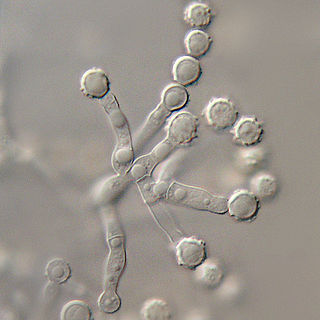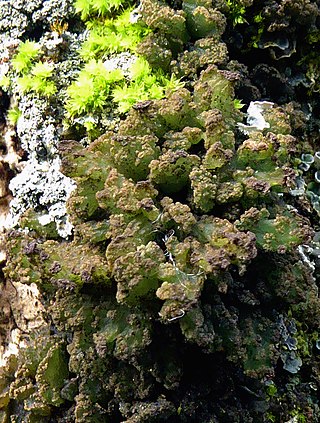
The Hypocreales are an order of fungi within the class Sordariomycetes. In 2008, it was estimated that it contained some 237 genera, and 2647 species in seven families. Since then, a considerable number of further taxa have been identified, including an additional family, the Stachybotryaceae. Wijayawardene et al. in 2020 added more families and genera to the order. According to the Catalog of Life, As of April 2021 the Hypocreales contains 6 families, 137 genera, and 1411 species. Hyde et al. (2020a) listed 14 families under Hypocreales, while, Wijayawardene et al. (2022) accepted 15 families in the order, where Cylindriaceae was additionally added. Earlier, Hyde et al. (2020a) had placed Cylindriaceae in class Xylariomycetidae. Samarakoon et al. (2022) agreed. Hence, Cylindriaceae should have been excluded from Hypocreales and placed in Xylariomycetidae. Xiao et al. (2022) recently introduced a new family Polycephalomycetaceae to Hypocreales.
Spegazzinia is a genus of widely distributed mitosporic ascomycete fungi in the family Didymosphaeriaceae.As accepted by Wijayawardene et al. 2020.

The Marasmiaceae are a family of fungi in the order Agaricales. Basidiocarps are most frequently agarics, but occasionally cyphelloid. According to a 2008 estimate, the family contained 54 genera and 1590 species, but molecular research, based on cladistic analysis of DNA sequences, has led to a more restricted family concept, so that the Marasmiaceae included just 13 genera, and some 1205 species. It was reduced further down in 2020, to 10 genera and about 700 species.

The Leotiomycetes are a class of ascomycete fungi. Many of them cause serious plant diseases.

Pleosporaceae is a family of sac fungi. They are pathogenic to humans or saprobic on woody and dead herbaceous stems or leaves.

Diaporthales is an order of sac fungi.

The Botryosphaeriales are an order of sac fungi (Ascomycetes), placed under class Dothideomycetes. Some species are parasites, causing leaf spot, plant rot, die-back or cankers, but they can also be saprophytes or endophytes. They occur world-wide on many hosts. For example, in China, infections related to Botryosphaeriales have been recorded on numerous hosts such as grapes, Caragana arborescens,Cercis chinensis, Eucalyptus, Chinese hackberry, blueberry, forest trees, and various other woody hosts.

The Dactylosporaceae or Sclerococcaceae are a family of lichen-forming fungi in the class Eurotiomycetes. It is the only family of the order Sclerococcales and subclass Sclerococcomycetidae.

The Microascaceae are a family of fungi in the class Sordariomycetes, subclass Hypocreomycetidae. The family was published by David Malloch in 1970, an emended description based on Everet Stanley Luttrell's original 1951 publication. Family was updated in 2020.

Phyllachora is a genus of fungi in the family Phyllachoraceae. An Outline of Fungi in 2020 listed up to 1513 species.
Immotthia is a genus of fungi in the family Roussoellaceae.
Appendiculella is a genus of fungi in the family Meliolaceae. About 70 species are accepted in 2020.
The Euantennariaceae are a family of fungi with an uncertain taxonomic placement in the class Dothideomycetes.
Spirographa is a genus of parasitic fungi. It is the sole genus in the monotypic family Spirographaceae, belong to the order Ostropales. The genus was circumscribed by Alexander Zahlbruckner in 1903, with Spirographa spiralis later assigned as the type species in 1923. The family Spirographaceae was circumscribed by Adam Flakus, Javier Etayo and Jolanta Miadlikowska in 2019 on the basis of molecular phylogenetic analysis. They determined that genus Spirographa is an independent lineage in the Ostropales, sister to the clade containing the families Fissurinaceae, Gomphillaceae, and Graphidaceae.

The Arctomiaceae are a family of lichenized fungi in the Ascomycota, class Baeomycetales. The family was named by Theodor Magnus Fries in 1861, with Arctomia as the type genus. Species in this family are found in arctic and subarctic habitats, usually associated with bryophytes.

The Apiosporaceae are a family of fungi in the Ascomycota. It was placed in the order Amphisphaeriales in 2020.
Dennisiella is a genus of fungi in the family Coccodiniaceae. It has 9 species. The genus was circumscribed by mycologists Augusto Chaves Batista and Raffaele Ciferri in 1962, with Dennisiella babingtonii designated as the type species. The generic name honours British mycologist R. W. G. Dennis. Fungi in this genus are epifoliar; that is, they live on living plant surfaces, particularly leaves.

The Leptosphaeriaceae are a family of fungi in the order Pleosporales. The family was circumscribed by mycologist Margaret E. Barr in 1987. According to the Dictionary of the Fungi, the family contained 8 genera and 302 species. The family has a widespread distribution, but is especially prevalent in temperate regions. Species are either saprobic or grow as nectrotrophs on the stems or leaves of plants.

Caliciales is an order of mostly lichenized fungi in the class Lecanoromycetes. It consists of two families: Caliciaceae and Physciaceae, which together contain 54 genera and more than 1200 species. The order was circumscribed by American botanist Charles Edwin Bessey in 1907.
Brachysporium is a genus of anamorphic fungi in the family Trichosphaeriaceae. It has 25 species. The genus was circumscribed in 1886 by Pier Andrea Saccardo, with Brachysporium obovatum assigned as the type species. The genus Cryptadelphia, circumscribed in 2004 to contain six presumed teleomorphs of Brachysporium, has since been placed in synonymy with Brachysporium.













